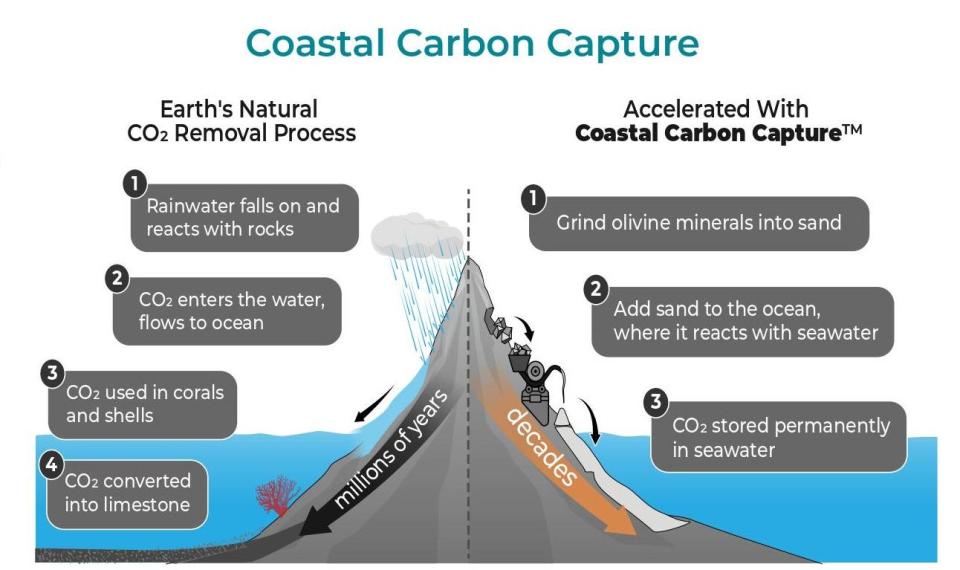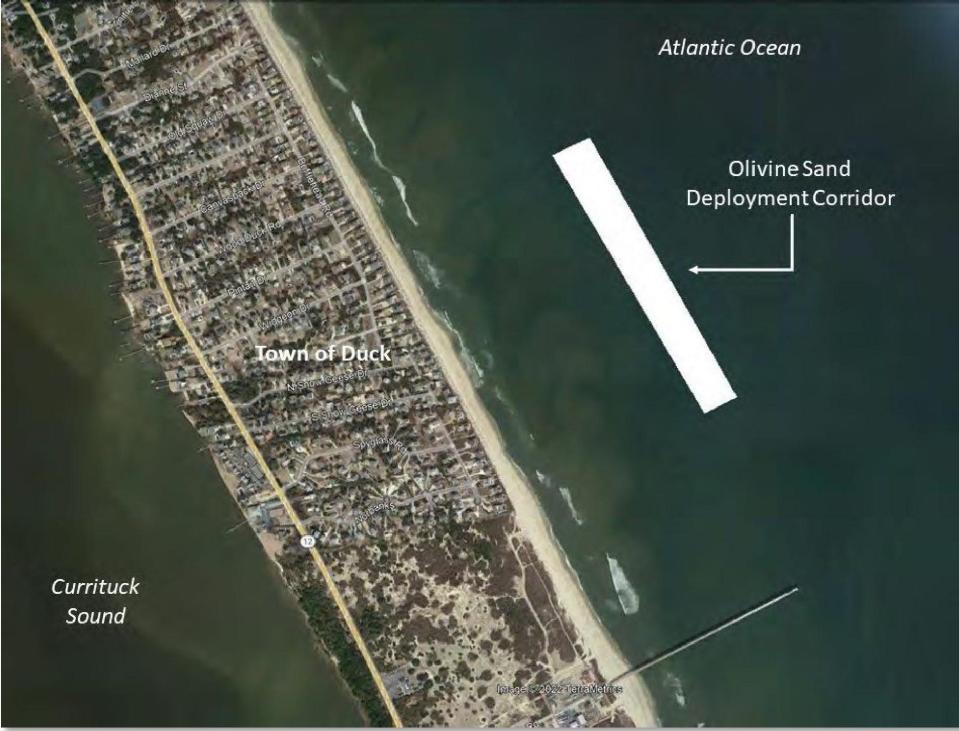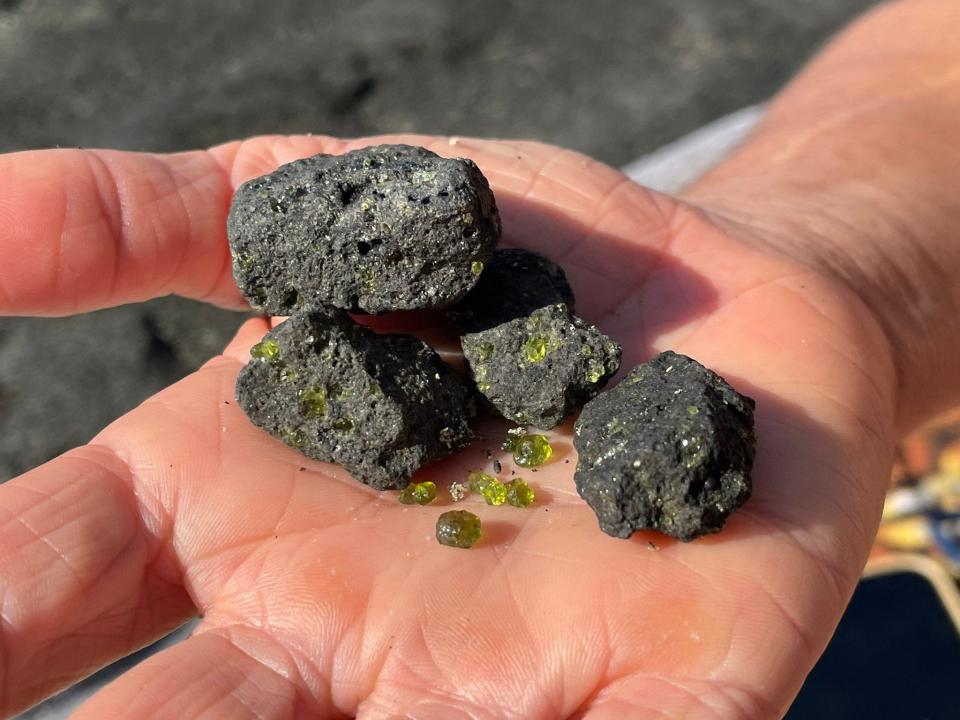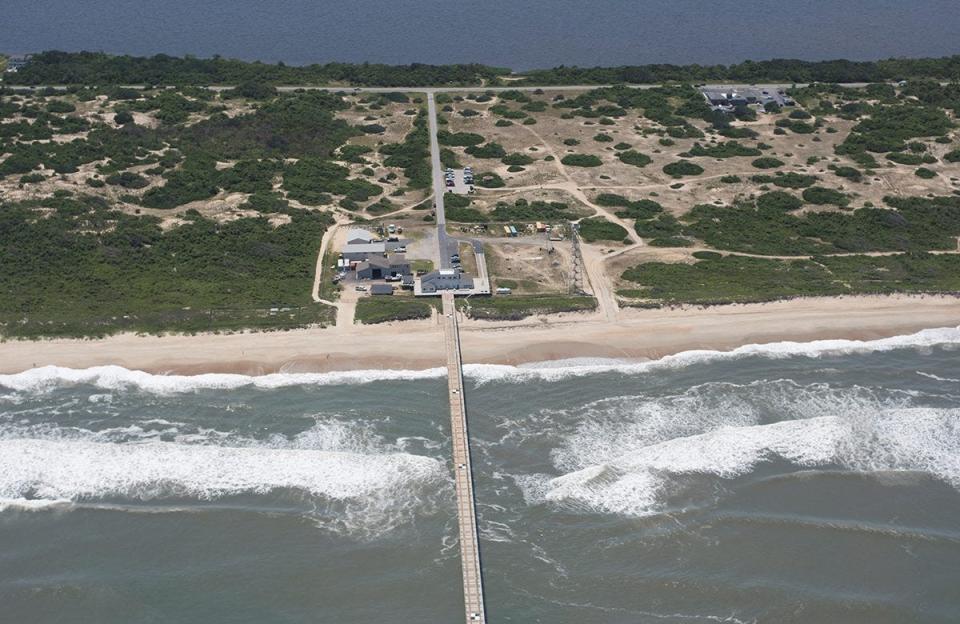Can adding volcanic rock to an Outer Banks beach help save the planet?
The Outer Banks are already on the frontline when it comes to climate change, but largely for the wrong reasons. Rising seas and ferocious hurricanes, both fueled by a warming climate, regularly threaten oceanfront homes and roads along the narrow strip of barrier islands off North Carolina's mainland.
Now, researchers are hoping to use those same beaches with a little help from a volcanic rock popular with jewelers to see if they can turn the tide on global warming.
Vesta, a California-based public benefit corporation that's researching climate change solutions, wants to sink 20,000 cubic yards of ground olivine, covering 75 acres, in 25-foot-deep water roughly 1,500 feet off Duck in the northern Outer Banks. The idea is to see if the "weathering" of the common mineral can safely reduce the acidity of the seawater and help remove carbon dioxide from the atmosphere.
ROAD TO NOWHEREThe NCDOT is ripping up old NC 12 on the Outer Banks. On purpose. Why?
"Vesta’s approach accelerates the carbon removal part of the carbonate-silicate cycle, which is an ancient natural process," states the company's website. "Our primary method for doing this is Coastal Carbon Capture, in which we add the natural mineral olivine, milled down to beach-compatible sand, to coastal protection projects. There, it gradually dissolves in the seawater, reducing ocean acidity and removing carbon dioxide from the atmosphere."

Carbon dioxide, tied to emissions from fossil fuels like coal and gasoline-powered cars, is the primary greenhouse gas emitted by humans that's helping warm the atmosphere, leading to profound climate change impacts around the world. Among the impacts attributed to climate change in North Carolina are rising sea levels, increased temperatures, and more powerful and larger hurricanes. While a lot of attention has been placed on reducing "active" emissions, like replacing coal-fired power plants with renewable energy sources, many climatologists have said carbon removal strategies to deal with the massive amounts of carbon dioxide already pumped into the atmosphere since the Industrial Revolution needs to be part of the solution.
FEAR THE RAIN?What ancient trees from New Bern to Wilmington are telling us about future flooding events
Enter olivine, an abundant volcanic rock named for its green hue and known to jewelers as peridot. According to Vesta, wide-spread deployment of olivine sand mixed with other material in beach-building projects and on shallow shelf sea areas holds the potential to remove billions of tons of carbon dioxide from the atmosphere.
"At scale, (Coastal Carbon Capture) projects can remove up to 20 times more (carbon dioxide) than they emit," states Vesta.

Although Vesta has conducted lab experiments and modeling and some small coastal projects, the Duck proposal, which could hit the water next summer, would be one of the largest real-world tests so far and the first conducted in the open ocean. The project's goals include reaffirming earlier research results regarding carbon capture and making sure the olivine-infused sand is safe for marine life.
"The need for the project is to gather pertinent information that will help determine the efficacy of the pilot project and to identify any limitations or constraints which could be resolved to help facilitate a full-scale deployment of olivine sand within the coastal and marine environment," states the project's permit application with the Army Corps of Engineers' Wilmington office.
A carbon eater or carbon nibbler?
While a big concept with plenty of questions still to be answered, Vesta's proposal has garnered support from major players in the environmental community, including Microsoft co-founder and climate change activist Bill Gates
.@mgrace_andrews of @Project_Vesta is using the natural mineral olivine and oceans to remove a trillion tons of carbon dioxide from the atmosphere. #WorldOceansDay pic.twitter.com/cGQaC9D6TC
— Bill Gates (@BillGates) June 8, 2022
Roger Shew, a coastal geologist at the University of North Carolina Wilmington, is intrigued by the possibilities of Vesta's proposal. He said the demonstration project should help answer questions about how quickly the "weathering" will take place and how much carbon will be sequestered.
"Weathering of olivine, like other materials, is enhanced with more surface area," Shew said via email. "This is why the rock/mineral will be crushed into sand-sized particles. Weathering is also enhanced if there is occasional movement of the materials. This is why placing them in the energetic wave zone would be important."

Vesta has held several meetings with Duck residents and town officials since first floating the proposed project last year, and while mostly positive some pointed questions have been raised.
Tom Green, Vesta's CEO and co-founder, said it's natural for folks to have questions about something that's new or that they're not familiar with. But he said the engagement with Duck residents and officials has been cordial, informative, and reflects the importance they take in protecting their town's quality of life and the overall marine environment.
Green added that the extensive research on olivine sand, the early data from our other test projects, and the intentionally small scale of the Duck project indicates that it should be able to remove carbon from the atmosphere without having a detrimental impact on the maritime environment.
Shew agreed that the low density of the olivine in the pilot project, its location offshore and the relatively small amount of material being deployed shouldn't impact the quality of the beach or marine life − including nesting sea turtles.
Green said the olivine for the Duck project would come from a mine in Norway, which is currently the largest olivine mine in the world. But if the project proves successful and there's a push to include olivine in other North Carolina beach nourishment projects or even those in other East Coast states, the Tar Heel State has plentiful deposits of the mineral. Shew said areas of Western North Carolina, especially around the Spruce Pine Mining District, are rich in olivine.
POWER OUTAGECould the slowing economy take the financial wind out of NC's offshore wind farms?
Help from your friends
But why choose a small resort town along the northern Outer Banks for the pilot project?
Well, one of the big reasons is the presence of the Army Engineer Research and Development Center’s Field Research Facility in Duck. Green said the lab's presence means the local beach and coastal areas are among the most studied and monitored in the country, allowing researchers to effectively track any impacts of the olivine sand on the local marine environment.
The corps also is helping fund Vesta's project, and officials at the lab are collaborating on it. Researchers from the University of North Carolina at Greensboro also would be involved in monitoring the project, according to the project's permit application.

Green said the cost of the Duck project, including research and monitoring costs, is estimated at $6 million. While that's a hefty sum for a relatively small project, he said larger olivine-infused beach projects would have the advantage of economies of scale and the further development of the "green" economy.
"The deployment of olivine sand will ultimately be subsidized by the sale of carbon credits generated by each project," he said via email. "As a result, it will be possible to include olivine in future shoreline protection projects without significantly adding to their cost."
WASHING AWAYNorth Topsail is getting millions for beach nourishment. How long will the sand last?
Shew said with climate change such a big issue facing society in the coming decades, having companies like Vesta investigating economically and environmentally beneficial solutions that can go hand-in-hand with efforts to curtail greenhouse gases getting into the atmosphere in the first place can only help.
"We need a tool box of solutions," he said. "Perhaps olivine is one of those tools."
Reporter Gareth McGrath can be reached at GMcGrath@Gannett.com or @GarethMcGrathSN on Twitter. This story was produced with financial support from 1Earth Fund and the Prentice Foundation. The USA TODAY Network maintains full editorial control of the work.
This article originally appeared on Wilmington StarNews: Volcanic rock added to Outer Banks beach could help capture carbon

